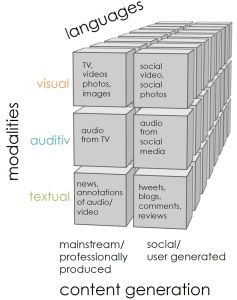Watching a film on the internet and recalling the corresponding comments or reviews: Supplying consumers with information from various media in various languages is the objective of the EU-funded xLiMe project coordinated by KIT. Algorithms read out contents of public media channels, such as text, audio, and video media, and link them thematically in cross-lingual and cross-media knowledge databases.
The media scene in Europe differs considerably from that of other countries, such as the USA or China. Information is generated in many different languages and disseminated via various data flows of stationary media channels. Various types of contents, such as texts, audio or video contributions, and various channels, such as traditional mass media or social media, make the situation even more complex. Public information can be evaluated for certain languages or media only. The knowledge supplied in knowledge databases remains fragmentary.
Overcoming these barriers and promoting the exchange of information are the objectives of the new EU-funded xLiMe project. xLiMe stands for crossLingual crossMedia knowledge extraction. Within the framework of xLiMe, seven partners from five countries develop solutions to interrelate information in various languages from various media channels in cross-lingual and cross-media knowledge databases and to make it available to consumers. This is accomplished in nearly real time, such that the knowledge transmitted by the media is comprehensive and updated continuously.
“The xLiMe project focuses on data that are not of personal character. We only study how many users consume certain media contents, but not which individuals do this. We do not generate user profiles!”, emphasizes the responsible project manager Dr. Achim Rettinger of the KIT Institute of Applied Informatics and Formal Description Methods (AIFB). KIT coordinates the project that started on November 01 and will have a duration of three years. Other partners are the Jožef Stefan Institute (Slovenia), the University of Trento (Italy), Intelligent Software Components S.A. (Spain), Zattoo Europa AG (Switzerland), VICO Research & Consulting GmbH (Leinfelden-Echterdingen), and econda GmbH (Karlsruhe). The budget totals about EUR 3.9 million. The European Union funds xLiMe with about EUR 3 million under the 7th Research Framework Programme.
Under xLiMe, the scientists plan to combine among others natural language processing, machine learning, and semantic technologies to search publicly accessible machine-readable knowledge in nearly real time. The instruments and methods developed in xLiMe will be tested among others in a case study covering internet TV and online shops and evaluated by several companies and up to 10 million end users.
xLiMe is to enable consumers, for instance, to extract additional relevant information from e.g. Twitter news when watching an internet TV channel. “Relevance of the contents of the media contributions is determined automatically,” project manager Dr. Achim Rettinger explains. “The media may contain written and spoken texts in various languages, photos, and videos. So far, relevance has only been determined for written texts in one language by comparing keywords, for instance.”
Within the joint project, KIT will integrate the contents extracted from various modalities. This means that the contents are disambiguated for the computer and interlinked. For this purpose, the researchers will use statistical data analysis methods and semantic technologies.
For further information, click http://www.xlime.eu
In close partnership with society, KIT develops solutions for urgent challenges – from climate change, energy transition and sustainable use of natural resources to artificial intelligence, sovereignty and an aging population. As The University in the Helmholtz Association, KIT unites scientific excellence from insight to application-driven research under one roof – and is thus in a unique position to drive this transformation. As a University of Excellence, KIT offers its more than 10,000 employees and 22,800 students outstanding opportunities to shape a sustainable and resilient future. KIT – Science for Impact.

